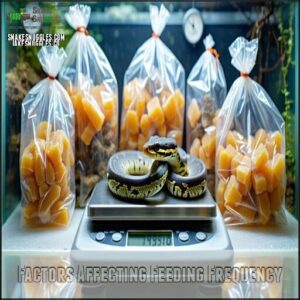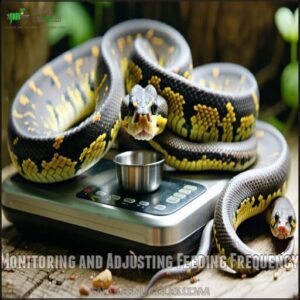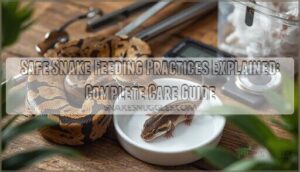This site is supported by our readers. We may earn a commission, at no cost to you, if you purchase through links.

Adult ball pythons typically eat every 7-14 days, while younger snakes need food more often—about every 5-7 days.
Your python’s appetite depends on its age, size, and metabolism.
A properly fed ball python should maintain a healthy body shape without visible spine or excessive bulk.
Like clockwork, most ball pythons settle into a predictable feeding routine once established.
Just remember that these snakes occasionally fast, especially during breeding season or when shedding.
Understanding these natural cycles can save you unnecessary worry about how often ball pythons eat, and recognizing a healthy body shape is crucial for their well-being.
Table Of Contents
- Key Takeaways
- Ball Python Feeding Basics
- How Often Ball Pythons Eat
- Factors Affecting Feeding Frequency
- Feeding Schedules by Age
- Choosing The Right Prey
- Feeding Techniques and Tips
- Common Feeding Mistakes to Avoid
- Monitoring and Adjusting Feeding Frequency
- Frequently Asked Questions (FAQs)
- How often should I feed my ball python?
- How do I know if my ball python is hungry?
- How long can a ball python go without eating?
- How long after a ball python eats does it poop?
- Should you feed ball pythons in their cage?
- Can I hold my ball python 24 hours after feeding?
- How often should you feed a ball python?
- How often should a ball python eat a mouse?
- Do ball pythons eat dead prey?
- Do ball pythons eat at night?
- Conclusion
Key Takeaways
- Feed young ball pythons every 5-7 days, juveniles every 7-10 days, and adults every 10-14 days, adjusting based on size, weight, and activity.
- Always pick prey weighing 10-15% of your python’s body weight and no wider than 1.5 times its thickest part to avoid digestion issues.
- Ball pythons eat best at night due to their natural hunting instincts; feed in a quiet, low-stress space for better success.
- Expect occasional fasting during shedding, breeding seasons, or environmental changes, but monitor weight and body condition to track health.
Ball Python Feeding Basics
You’ll need to feed your ball python whole prey items sized to about 10-15% of their body weight, with feeding frequency varying from weekly for growing juveniles to every 2-3 weeks for adults.
Properly sized rats or mice offer complete nutrition for your snake, ensuring they receive all the essential nutrients without risking digestive issues from prey that’s too large.
Dietary Requirements
Your ball python’s dietary requirements are surprisingly simple yet specific.
As obligate carnivores, they need whole prey for complete nutrition.
Their wild diet includes small mammals, birds, and occasionally reptiles, providing essential calcium needs and nutritional content.
You must never offer meat scraps or partial meals – these lack essential nutrients.
Prey variety is key to mimicking natural feeding patterns, ensuring your python receives balanced nutrition throughout its life.
Prey Size Guidelines
How precisely should you size your ball python’s meals? The ideal prey should weigh 10-15% of your snake’s body weight and never exceed 1.5 times its widest point.
This midsection ratio prevents regurgitation risk and obstruction avoidance. For young pythons, smaller is safer, while adult pythons require larger prey appropriate to their size.
Remember, when in doubt, choose the smaller option to keep your python healthy. Owners should also be aware of proper thawing techniques to prevent bacterial contamination.
Prey Type Recommendations
Your python’s prey choices should include more than just rodents for balanced nutrition. Rats and mice form the dietary backbone, but offering chick benefits like higher calcium can supplement your ball python feeding regimen.
Consider Reptilink alternatives if whole prey feeding concerns you. For additional options, explore ball python chicks as a supplemental food source.
Nutritional comparison shows hamsters contain more fat than rats, while chicks provide superior calcium levels. This prey enrichment strategy guarantees your snake receives balanced nutrition through variety to make certain your snake’s diet is the best it can be for its health.
How Often Ball Pythons Eat
Three key factors determine how often your ball python eats in captivity. Feeding frequency varies substantially from their wild counterparts, where they might only consume 10 meals annually.
- Your hatchling needs food every 5-7 days to support rapid growth
- Juveniles thrive on a 7-10 day ball python feeding schedule
- Adult snakes typically eat every 10-14 days, depending on size
- Older pythons (5+ years) may naturally skip meals, eating every 14-30 days
Regular weight monitoring helps you adjust schedules appropriately. To prevent deficiencies, consider dusting prey with a calcium and multivitamin mix monthly. The ideal frequency balances proper nutrition without overfeeding, maintaining your snake’s health long-term.
Factors Affecting Feeding Frequency
You’ll need to adjust your ball python’s feeding schedule based on its age, size, activity level, and environment. Your snake’s metabolism changes throughout its life, so feeding frequency isn’t one-size-fits-all.
Age and Size Considerations
Your snake’s age and size directly impact how often they need to eat.
Age and size are key—young ball pythons need frequent meals, while adults thrive on fewer, well-timed feedings for optimal health.
Hatchlings burn through energy faster, requiring smaller portions every 5-7 days to support rapid growth.
Juveniles need prey items every 7-10 days as their metabolism slightly slows.
Adult ball pythons can go longer between meals—typically every 10-21 days.
Regular weight monitoring helps you adjust feeding frequency as your python grows, which is a key factor in determining the optimal feeding schedule for your ball pythons, and ensuring their rapid growth.
Energy Needs and Activity Level
Your ball python’s activity level directly impacts its feeding frequency. These crepuscular hunters are relatively inactive, with slower metabolic rates than active snake species.
Female ball pythons need approximately 17 grams weekly (900g annually), while males require just 8 grams weekly (420g annually).
Many captive ball pythons become obese due to excessive feeding combined with limited movement. Always adjust your feeding schedule based on your snake’s activity patterns and thermal regulation needs.
Environmental Factors
Your ball python’s environment directly impacts their feeding habits.
Temperature gradients of 75-95°F and humidity levels of 50-60% create ideal digestion conditions.
Smaller enclosures may stress your snake, while proper hiding spots encourage security and healthy feeding responses.
Seasonal changes often trigger natural fasting periods—many ball pythons eat less during winter months, even in captivity.
Monitoring these environmental factors helps establish an effective reptile feeding guide.
Feeding Schedules by Age
You’ll need to adjust your ball python’s feeding schedule as it grows from a hungry hatchling to a mature adult.
Your snake’s age directly determines how often it needs to eat, with younger pythons requiring more frequent meals than their older counterparts, which is a complete concept to understand for proper care.
Hatchling Feeding Schedule
Now that you understand what impacts feeding patterns, let’s focus on your hatchling’s meals.
Young ball pythons need food every 5 days until they reach 300 grams. Their prey items should weigh 10-15% of their body weight.
Keep track with a digital kitchen scale, weighing your hatchling weekly to monitor growth. For best results, feed within the enclosure to reduce stress and encourage eating, using prey that is the right size for your hatchling’s meals.
Juvenile Feeding Schedule
As your hatchling grows, your juvenile ball python‘s feeding schedule shifts to every 7-10 days.
You’ll want to maintain prey items at 10-15% of their body weight for ideal growth monitoring.
Feeding consistency helps track development in these young pythons.
- Watch how your snake’s feeding response strengthens with each successful meal
- Notice the visible growth spurts after consistent feeding cycles
- Feel the satisfaction when your juvenile readily accepts its appropriately-sized rat, which is a key indicator of successful feeding consistency.
Adult Feeding Schedule
Once your ball python reaches adulthood, feeding frequency decreases substantially.
Adult males (800+ grams) should eat every 10-14 days, while females (1400+ grams) need food every 7-10 days.
Prey should be 7-10% of their body weight, and monthly weight monitoring confirms proper health.
Some keepers use erratic schedules to stimulate natural feeding responses, unlike wild pythons that eat sporadically, captive adults maintain regular feeding patterns, following a regular feeding routine.
Choosing The Right Prey
You’ll need to select prey that’s about 10-15% of your ball python’s body weight, with rats and mice being the most common options.
The right prey size should never exceed 1.5 times the widest part of your snake’s body to prevent health issues and guarantee proper digestion.
Prey Size and Type Selection
Selecting the right prey is essential for your ball python’s health. Your snake needs appropriately sized food – about 10-15% of its body weight and no wider than 1.5 times its midsection.
When choosing prey, consider:
- Size relative to your snake’s girth
- Nutritional needs based on age
- Prey type (rats generally offer better nutrition than mice)
- Variety to mimic wild diet patterns
Many owners find success when using appropriately sized rats. Never feed items too large as this can cause regurgitation.
Nutritional Value of Prey
Now that you’ve selected the right size, what’s inside that prey matters tremendously.
Rats offer excellent nutritional value for your ball python, containing ideal protein levels while being relatively lean.
| Prey Type | Protein % | Fat % | Calcium % | Vitamin A (IU/kg) |
|---|---|---|---|---|
| Mice | 55 | 23 | 2.9 | 578,272 |
| Rats | 59 | 23 | 2.62 | 151,389 |
| Chicks | 64 | 22 | 13.69 | 35,600 |
| ASF | High | Low | Medium | Medium |
The table provides a comparison of different prey types, including mice, rats, chicks, and ASF, highlighting their nutritional content.
Variety and Rotation of Prey
Beyond the nutritional content, your ball python’s diet benefits from variety.
While most owners stick to rats or mice, rotating prey items mirrors a snake’s wild diet and provides different nutritional profiles.
Try offering quail, chicks, or hamsters occasionally.
This prey rotation prevents food boredom and guarantees your snake receives a full spectrum of nutrients.
Some keepers switch between feeder types monthly, creating nutritional diversity without disrupting feeding patterns.
Feeding Techniques and Tips
You’ll find that mastering proper feeding techniques makes all the difference between a thriving ball python and a reluctant eater.
Using thawed prey and feeding tongs keeps your snake safe and also helps maintain a consistent feeding response.
Frozen/Thawed Prey Vs Live Prey
After selecting prey size, you’ll need to decide between live or frozen/thawed options.
Most experienced keepers prefer frozen/thawed prey for ball python feeding due to safety concerns.
Live prey can injure your snake, while frozen options eliminate this risk.
Though live feeding may trigger natural hunting behaviors, frozen/thawed prey offers better convenience, storage benefits, and addresses ethical concerns about prey animal welfare.
Frozen-thawed prey also offers reduced bacterial growth, making it a healthier option.
Your snake’s preference ultimately matters most.
Thawing and Heating Prey Items
Properly thawing and heating your ball python’s frozen prey is essential for both safety and feeding success.
Improper methods can lead to bacterial growth or feeding refusal.
- Never microwave prey items as this creates dangerous hot spots
- Thaw frozen prey in the refrigerator overnight to prevent bacterial growth
- Use a temperature gun to verify prey has reached 98-100°F
- Place thawed prey in a BPA-free bag before warming in hot water
- Warm prey immediately before feeding to maximize scent appeal
Many owners find success using specialized rodent thawing equipment.
Ideal Feeding Time and Environment
Three key factors affect your ball python’s feeding success: timing, environment, and setup.
Feed at dusk or early evening when these nocturnal hunters are naturally active.
Keep the enclosure quiet with minimal disturbances, and maintain proper temperature gradients (75-80°F cool side, 88-92°F warm side) and dim lighting during feeding time.
This stress reduction approach mimics their natural feeding conditions and improves their feeding response.
Common Feeding Mistakes to Avoid
You’ll quickly damage your ball python’s health with common feeding errors like incorrect prey size or poor hygiene.
Even experienced owners make these mistakes, but you can avoid them by understanding proper feeding fundamentals, such as recognizing the importance of common feeding errors.
Overfeeding and Underfeeding
Recognizing the balance between overfeeding and underfeeding your ball python prevents serious health consequences.
Obesity risks include appetite loss and flabbiness, while underfeeding leads to lethargy and stunted growth.
Monitor your snake’s weight regularly with these signs:
- Healthy pythons have rounded body shape without visible spine
- Overweight pythons feel flabby when handled
- Underweight pythons develop a triangular body cross-section
Adjust snake feeding frequency based on body condition rather than strict schedules. To guarantee proper nutrition, owners should avoid poor prey quality to prevent health issues.
Inadequate Prey Size and Type
While avoiding overfeeding is important, feeding inappropriate prey can be just as harmful.
Your ball python needs correctly sized meals matched to its body dimensions.
| Issue | Cause | Effect |
|---|---|---|
| Growth stunting | Too-small prey | Insufficient nutrients |
| Regurgitation issues | Oversized items | Digestive strain |
| Nutritional deficiencies | Lack of prey variety | Health problems |
Aim for prey 1-1.5 times your snake’s midsection width.
Rotating between mice and rats provides better nutrition than a single-prey diet, helping prevent nutritional deficiencies.
Poor Feeding Techniques and Hygiene
Beyond sizing issues, poor feeding techniques and hygiene can endanger your ball python’s health.
Unsanitary conditions create breeding grounds for harmful bacteria that can cause infections.
Here are 5 common feeding hygiene mistakes:
- Handling prey with unwashed hands
- Using soiled food that’s been on the floor
- Cross-contamination between prey items
- Maintaining unhygienic enclosures during feedings
- Causing stressed feeding by not providing privacy
Monitoring and Adjusting Feeding Frequency
You’ll need to watch your ball python’s body condition and behavior closely to adjust feeding times as they grow.
Regular weighing and observing how they respond to meals helps you create the perfect feeding schedule for your snake’s health.
Recognizing Signs of Hunger and Satiety
Watchfulness helps you spot when your ball python is hungry before feeding time.
Your snake’s active hunting behavior—prowling the enclosure edges or tongue-flicking rapidly—signals hunger.
Look for a good body condition with gentle spine curve.
After meals, a satisfied snake retreats to its hide.
Shedding impact can temporarily halt feeding response.
Learn your pet’s unique snake feeding habits to prevent refusal reasons and regurgitation signs.
Adjusting Feeding Frequency for Growth and Health
Everyone should adjust their ball python’s feeding frequency based on growth stage and body condition.
Monitor weight regularly and observe the tail taper to confirm proper development.
- Young pythons (under 1 year) need more frequent feeding (every 5-7 days) to support rapid growth
- Adult pythons benefit from reduced feeding frequency (every 10-21 days) to prevent obesity
- Skip meals temporarily if your snake shows poor feeding response or appears overweight
Consulting a Veterinarian for Feeding Issues
While helping your ball python maintain healthy growth, you’ll want to watch for warning signs that require veterinary attention.
If you notice persistent feeding refusals, unexplained weight loss, regurgitation causes, or dietary deficiencies, don’t wait to see a reptile veterinarian.
Snake health monitoring should include annual fecal exams.
Most snake feeding problems can be resolved with proper diagnosis—never attempt force-feeding without specialist referral, as this can worsen snake diseases.
Frequently Asked Questions (FAQs)
How often should I feed my ball python?
Feed hatchlings every 5-7 days, juveniles every 7-10 days, and adults every 10-14 days.
Adjust based on your snake’s size, weight, and activity, ensuring prey is appropriately sized to maintain health and growth.
How do I know if my ball python is hungry?
Your ball python might roam its enclosure, become more active at night, or show interest in movement.
If it flicks its tongue frequently when you’re near, it could be searching for food.
How long can a ball python go without eating?
In captivity, a healthy, well-fed adult ball python can safely go up to three months without eating.
Younger snakes shouldn’t exceed a month without food, as their energy needs are higher for growth.
How long after a ball python eats does it poop?
Your ball python will typically poop about 5-7 days after eating, depending on meal size and their digestion.
Watch for signs like reduced activity, as they often relax before passing waste.
Should you feed ball pythons in their cage?
Feeding your snake in its cage is like dining in your favorite corner.
It’s stress-free and natural for them.
Just use tongs to prevent accidental bites, and always supervise for safety.
Can I hold my ball python 24 hours after feeding?
Wait at least 48 hours before handling your ball python after feeding.
Handling too soon can stress them or cause regurgitation, which isn’t fun for anyone.
Give them time to digest comfortably before interacting.
How often should you feed a ball python?
How often do you offer dinner to your scaly friend?
Feed hatchlings every 5-7 days, juveniles every 7-10 days, and adults every 10-14 days.
Adjust schedules based on age, size, and activity.
How often should a ball python eat a mouse?
You should feed your ball python a mouse every 5-7 days if it’s young.
For adults, offer a mouse every 10-14 days.
Adjust based on its size, weight, and feeding behavior.
Do ball pythons eat dead prey?
Yes, ball pythons willingly eat dead prey, like frozen-thawed or pre-killed food.
It’s safer and prevents injury.
Thaw prey properly, warm it slightly to feel natural, and use feeding tongs for safety.
Do ball pythons eat at night?
When it’s dark, ball pythons become more active hunters, making night the perfect time to feed them.
Their nocturnal nature means they instinctively associate darkness with hunting, ensuring a better feeding response.
Conclusion
Imagine this scenario: your ball python skips a meal, and you panic.
Don’t worry—it’s normal! Knowing how often ball pythons eat is key to keeping them healthy.
Adults usually feed every 7-14 days, while younger ones eat more often.
Stick to proper prey size and watch for natural fasting during shedding or breeding seasons.
Keep your snake’s body condition in check and adjust meals as needed to support a thriving ball python.
With consistency and care, you’ll support a thriving ball python.


















